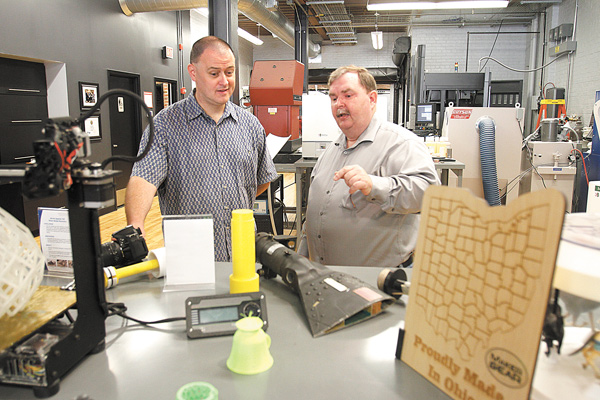America Makes “a 3D shop on steroids”


T.J. McCue, a national author, left, watches as Kevin Collier of America Makes shows how a part made through 3-D manufacturing helps fix the bearing for an Apache helicopter.
YOUNGSTOWN
T.J. McCue knew about America Makes; he knew people who had talked about the creation of the facility, yet he was still surprised and impressed by what he saw on his visit Tuesday.
McCue, who writes about 3-D technology, came to America Makes as part of his 3DRV project that focuses on looking at how 3-D manufacturing technology is being blended into industry. The 3-D manufacturing process builds products by adding material to create an item, as opposed to standard manufacturing, which makes items by cutting away from larger pieces of material. There is minimal waste in 3-D manufacturing.
“This is like a 3-D shop on steroids,” he said of America Makes. “Even Ford doesn’t have the diversity in its equipment.”
McCue added it might not be fair to compare America Makes to any other facility in the country because of the amount of private and public investment that has gone into it.
There has been $15 million each in private and public funding for projects at America Makes since it opened, said Scott Deutsch, manager for communications and special projects at America Makes.
McCue said he expected America Makes to be more of a bureaucratic location, not somewhere where a lot of projects were being done.
The goal of the facility is to get groups that wouldn’t normally work together, or might even be competitors, to participate in a common project, Deutsch said.
In these instances, the companies along with America Makes share in the risk, but they also share in any rewards, he said.
“3-D manufacturing is no longer something from James Bond or science fiction,” Deutsch said.
It’s something that has appeared in popular culture on shows such as “Grey’s Anatomy” and “Big Bang Theory,” he said. “My hope is that someday someone [on television] applies for a grant through America Makes to build something.”
One of the current issues with 3-D manufacturing developing more in the corporate world is that companies don’t yet know how products will react, said Kevin Collier, manager at America Makes. These companies have decades of data on current products.
“For the 3-D products, we’re trying to create a database,” he said.
Despite concerns about the cost of making things, there are many developments that have saved money. For example, there is a product made through 3-D manufacturing for jets that despite having a higher up-front costs starts saving money after seven to eight years, Collier said. The part lasts 30 years.
The 3-D technology has the ability to do some incredible things, McCue said.
“I see it as the future,” he said. “The question is do we reach a point where a company like Legos just sells plans for their toys and people can build them on their 3-D printer and adjust them if they want.”
There will be some people who will want to have their own 3-D technology at home and others who will be happy to send items to a place such as the UPS Store where they will be able to print them, McCue said.
“Who knows what things [with 3-D printing] will be like in 10, 20 or even 50 years,” he said.
 43
43
